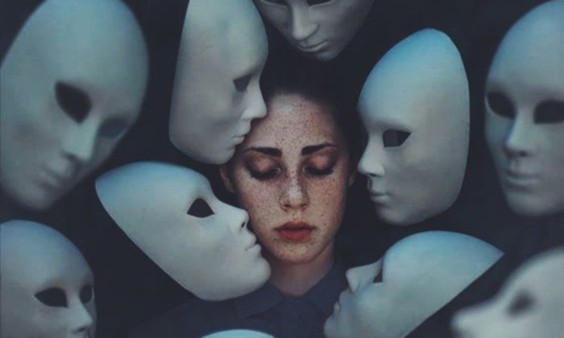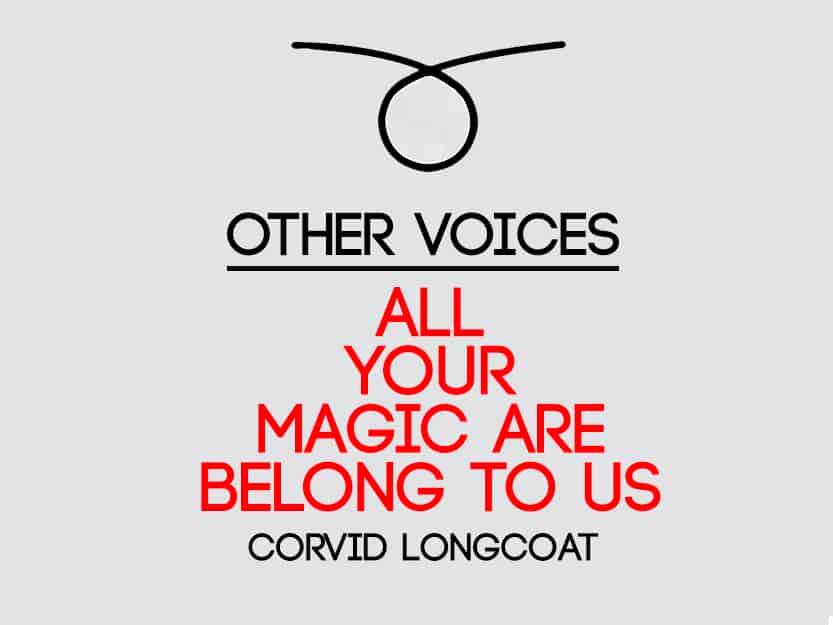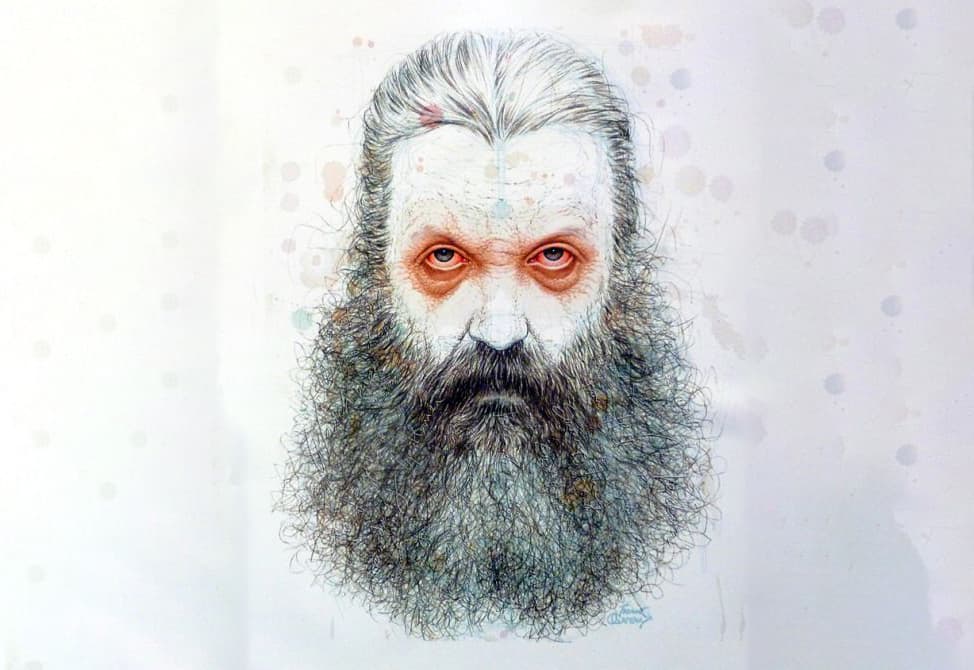So hello good people of the internet, welcome to another OTHER VOICES, the series in which I shut up for a while and let my favourite people talk for a while. This one sees a return of Corvid Longcoat, this time on the shamanic roots of magic…

One perennial claim which pops up a lot in magical circles is the ancient provenance and thus [apparently] enormous power of a specific system. Practitioners often romanticise their chosen tradition, or occasionally, another from which they wish to draw.
Some examples from my bookshelf include:
- Stephen E Flowers’ implicit claim in Original Magic that the operations of the Persian magoi–from whom the Greeks adapted the word magi and thus the derivation of our word magic—constitutes some kind of origin of all our practices;
- Kabbalistic claims of books of magic given to Adam, texts written by Abraham, etc;
- Sumerian connections for the Cthulhu Mythos-based magic, showing [along with Crowley’s Egyptian/Sumerian themes] that claims of ancient power are not limited to ancient systems;
- Claims that African Traditional Religions [mostly accessed in their New World variations] are 8-10,000 years old.
These assertions sit at odds with research and common sense. Even a quick look at how religions which have been practiced for a couple of thousand years like Judaism shows massive evolution and variation in practice. The notion that—for example—Candomblé or Vodou with admixtures of Native American, Christian and in some cases Jewish ideas and practices is “the same” as West African religion from pre-colonial times to which we have extremely limited access sounds silly. This applies even more to magical systems, which are notoriously polyglot, taking practices where they are found and adapting them.
However bringing our ideas of the history and evolution of our practices into line with historical and anthropological research need not diminish the power, beauty or variety of these systems. A detour may help us here, so bear with me.
Magic and Art
I’m not fully “out” as a magician with my entire social circle, and when hints of my practice—as opposed to academic study—arise, I rely on a standard response: “It’s more of an art project, really.” While glib, this connection of magic and art has enormous relevance.
We could look at the theory and work of Austin Osman Spare, whose sigil practice and overall approach influenced contemporary Chaos Magic. Spare of course was a working artist and art and creativity played a large role in his magical practice and approach.
Our own Tommie Kelly, Chaos magician extraordinaire and creator of the Forty Servants, is also a practicing artist, and has drawn connections between artistic/creative practice and magical practice.
Grant Morrison and Alan Moore are additional examples of deep connections between magical and artistic practice, with Moore explicitly saying things like “For me, there is very little difference between magic and art. To me, the ultimate act of magic is to create something from nothing: It’s like when the stage magician pulls the rabbit from the hat.” And whatever one may think of Michael M Hughes’ large “Bind Trump” project in political or magical terms, he and others in his group have explicitly noted the aspect of collective performance art such a public spell has.
Perhaps most tellingly, Jean Clottes, in his work What Is Paleolithic Art? makes a link between rock art—perhaps the earliest documented human creativity—and shamanic practice. It is this link which will prove fruitful for validating the power and beauty of the wide variety of magical systems which have been preserved, reconstructed, constructed, channeled, found, or what have you.
Clottes is an archaeologist, famous for discovering and working with the Chauvet caves in Southern France, which house rock art from as much as 32,000 years ago. The book surveys rock art from every continent not completely covered in ice, indicating that the phenomenon was widespread. His thesis—perhaps unprovable but highly plausible—is that this art formed part of early shamanic practice. Of course rock art is difficult to interpret completely, but Clottes makes a powerful case for his view.
What can be pieced together from the archaeological evidence [albeit with some informed speculation] is that rock art points to some combination of creativity and shamanic practice. Just to draw the link out, many themes in magical systems arise in shamanic practice as evidenced in the caves and Clottes identifies them:
- Initiation, often in underground caves.
- Cosmological instruction; the figures often include stars, animals, plants, geography, etc
- Trance states; this is partly indicated by some of the bizarre combinations of images [the famous Lion Man in Southern Africa, e.g.], and partly by Clottes’ and others’ interrogation of indigenous peoples who in
- some cases still use or produce rock art.
- Shifting reality; some figures are seen in ceremony, and appear to be affecting other figures
- Joining with angelic/divine/demonic forces; again the combination images and practitioner testimony speak of humans “becoming” animals and spirits
- Secrecy and separation; some art seems to have been very public, and some seems to have been reserved for specific groups, girls, women, boys, men, and potentially more restricted groups.
If you’re the kind of person who’s interested, I recommend visiting a rock art site and slipping into that receptive trance state common across magical practice. You’ll be surprised and not surprised at the kinds of information that come through. I spent some time in Namibia visiting rock art sites, and also visited the Rock Art Research Institute at the University of the Witwatersrand in Johannesburg. What’s striking to a practitioner is how clearly connected these earliest manifestations of human magical and creative power feel to the magic we do now.
Parenthetically, I’d love to put together some curious magicians and gently perform ceremony at a range of these rock sites to see what can be gathered.

Why This Matters for Contemporary Magic
The origin of human creativity [as Clottes says] is also the origin of shamanic practice, and rock art shows evidence of connection to shamanic practice. Of course “shaman” comes from the Tungus people of Northern Siberia, and Mircea Eliade found common themes in Central Asian shamanism which get spread across migration patterns.
But crucially, these themes seem to emerge wherever we find rock art, and that’s pretty much everywhere. Rock art sits alongside the earliest human remains, and examples span the globe, presumably carried along with human migration. “Shaman” acts as a placeholder, as we don’t have other words. Or rather, we have lots of other words: mage, witch, healer, sorcerer, wizard, cunning woman, cunning man, medicine carrier, priestess/priest etc.
This does not imply that all these traditions are the same. Far from it. But they share features like trance, shapeshifting/possession, communication with invisible forces, capacity to affect reality, and use of natural magic. We can make an argument that magical practice everywhere—and at all times–has its roots in shamanic practice. Christopher Penczak, another contemporary magician, has done just that with his work on “Shamanic Witchcraft,” recasting how many think of magic in shamanic terms.
And shamanic practice seems linked up with the universal early rock art/trance phenomenon. Everybody did it. And it’s a fundamental part of human experience.
So we can see how something explicitly non-continuous like Kenneth Grant’s Typhonian Tradition—which emerges in culturally disparate places and times—has another layer of relevance. These themes in early human shamanism and art also show up spontaneously in nearly every culture and magical tradition. The themes of course come from universals of human experience: Birth, Death, Youth, Growth, Old Age, Sex, Family/Kinship, Nature/Seasons, Violence, Bargaining, Power/Status, Unity, Diversity and others.
The take-away message is that whether your system claims to be thousands of years old, or is a modern reconstruction, or indeed a modern invention out of whole cloth, it has its roots in these fundamental practices apparently engaged in by our earliest ancestors.
Magic is a universal human practice which supports incredible variation in practice, cultural context, and orientation. Status seeking seems to be the root of most denigrations of other systems, or assertions about the age and power of one’s own. Nor is there cause to ignore historians’ and academics’ insights into the growth and change of these systems. When systems hit those universal themes, use trance, meditation and focus to underpin technique, and direct change in the observable world through the non-observable world, they are authentic. I work with systems which claim to be thousands of years old, but are more likely to be 800, or even 300 years old, as well as systems which just celebrated their second birthday. They work beautifully.
Rather than a “can’t we all just get along” plea, understanding these roots enables us to appreciate the power and beauty of our own systems, to innovate and adapt them, to appreciate other systems in their uniqueness, and to learn from everyone. That will make us and our systems stronger, more resilient, and more in tune with the oldest transformative magical/art practices known to humans. And that’s got to be good.

Corvid Longcoat is a Black Jewish Taoist part-Scottish martial artist practising in a number of occult and magical streams, including of course The Forty Servants. He lives in the US, and also studies the history and anthropology of the occult. He is not a witch.
NOTES:
Masks photo by anka_zhuravleva_arts
Alan Moore by Frank Quitely
LINKS AND PROMOTION STUFF:
BLOG
– ADVENTURES IN WOO WOO
THE FORTY SERVANTS
– All Info on The Forty Servants
– Forty Servants Altar Cards
– Buy The Forty Servants
– Buy the Grimoire
THE FOUR DEVILS
– INFO AND DOWNLOADS
– SIGNED ALTAR CARDS/ ART PRINTS
MEDIA
– Tommie Kelly Podcast
– Tommie Kelly Youtube
SOCIAL
– Adventures in Woo Woo Facebook
– The Forty Servants Facebook Group
– Twitter
PHOTOGRAPHY
– 500 PX
– FLICKR
– Instagram
–

